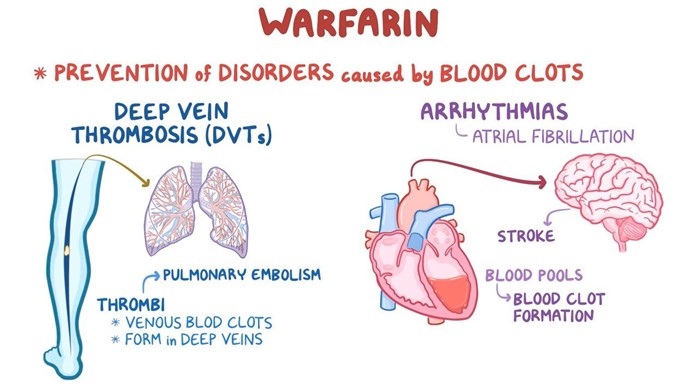A client is being discharged with a prescription for warfarin. Which instruction should the nurse provide this client regarding diet?
Increase the intake of dark green leafy vegetables while taking warfarin.
Eat two servings of dark green leafy vegetables daily and continue for 30 days after warfarin therapy is completed.
Eat approximately the same amount of leafy green vegetables daily so the amount of vitamin K consumed is consistent.
Avoid eating any foods that contain any vitamin K because it is an antagonist of warfarin.
The Correct Answer is C
Choice A reason: Increasing the intake of dark green leafy vegetables while taking warfarin is not a good instruction because it can decrease the effectiveness of warfarin. Dark green leafy vegetables are rich in vitamin K, which is a coagulation factor that counteracts the anticoagulant effect of warfarin.
Choice B reason: Eating two servings of dark green leafy vegetables daily and continuing for 30 days after warfarin therapy is completed is not a good instruction because it can cause bleeding complications. Dark green leafy vegetables are rich in vitamin K, which is a coagulation factor that counteracts the anticoagulant effect of warfarin. Stopping warfarin while continuing to eat high amounts of vitamin K can increase the risk of clot formation and thromboembolism.
Choice D reason: Avoiding eating any foods that contain any vitamin K because it is an antagonist of warfarin is not a good instruction because it can cause bleeding complications. Dark green leafy vegetables are rich in vitamin K, which is a coagulation factor that counteracts the anticoagulant effect of warfarin. Eliminating vitamin K from the diet can increase the sensitivity to warfarin and cause excessive bleeding and bruising.

Nursing Test Bank
Naxlex Comprehensive Predictor Exams
Related Questions
Correct Answer is D
Explanation
Choice A: Advising the client to place one nitroglycerin tablet under his tongue as a precaution is a dangerous action for the nurse, as this can cause severe hypotension and cardiovascular collapse due to the interaction between tadalafil and nitroglycerin. This is a contraindicated choice.
Choice B: Telling the client to have someone bring him to an emergency department immediately is an unnecessary action for the nurse, as there is no evidence of any serious adverse reaction or complication from tadalafil. This is an overreaction choice.
Choice C: Instructing the client to increase his intake of oral fluids until the skin flushing is relieved is not an appropriate action for the nurse, as this does not address the cause of the flushing, which is vasodilation due to tadalafil. This is a distractor choice.
Choice D: Reassuring the client that skin flushing is a common side effect of the medication is an appropriate action for the nurse, as this can calm the client and educate him about the expected effects of tadalafil. Therefore, this is the correct choice.
Correct Answer is B
Explanation
Choice A: Assigning the UAP to provide care for another client and assume full care of the client is not an action that the nurse should take, as this is unnecessary and inefficient. The UAP can safely assist the client with influenza if they follow proper infection control measures. This is an incorrect choice.
Choice B: Reviewing the need for the UAP to wear a face mask while in close contact with the client is an action that the nurse should take, as this can protect the UAP and others from droplet transmission of influenza. This is a standard precaution that should be reinforced by the nurse. Therefore, this is the correct choice.
Choice C: Instructing the UAP to apply a fitted respirator mask before entering the client's room is not an action that the nurse should take, as this is not indicated for a client with influenza. A respirator mask is required for airborne transmission, not droplet transmission. This is another incorrect choice.
Choice D: Directing the UAP to notify the nurse of any changes in the client's respiratory status is not an action that the nurse should take, as this is a general instruction that does not address the specific issue of infection control. This is another incorrect choice.
Whether you are a student looking to ace your exams or a practicing nurse seeking to enhance your expertise , our nursing education contents will empower you with the confidence and competence to make a difference in the lives of patients and become a respected leader in the healthcare field.
Visit Naxlex, invest in your future and unlock endless possibilities with our unparalleled nursing education contents today
Report Wrong Answer on the Current Question
Do you disagree with the answer? If yes, what is your expected answer? Explain.
Kindly be descriptive with the issue you are facing.
